Results 6,461 to 6,470 of 12094
Thread: Anandtech News
-
11-15-16, 08:43 AM #6461
Anandtech: Toshiba Finalizes Plans for New 3D NAND Fab: Coming Online in 2019
Toshiba in the past week has finalized plans to build a new production facility to make 3D NAND flash memory. The company will start construction in early 2017 and in addition to a new manufacturing site Toshiba will also build a new R&D center. Toshiba is still talking with its partner Western Digital about joint investments in the new facility, but no matter what, the building will be completed in mid-2018 and the fab will start high volume production in 2019.
Toshiba intends to start construction of the first phase of its new fab in February 2017 and no decisions about the second phase of the project have been made so far. The building is set to be complete inside and out sometime in summer 2018 and then the company will have to move in equipment, which takes two to three quarters. If everything goes smoothly, the fab will produce its first 3D NAND wafers in late 2018, but high volume commercial production will start in calendar 2019. We are told that the building will have a quake-absorbing structure and will also use an environmentally friendly design that includes LED lighting.
The manufacturer will finalize decisions regarding exact production capacity as well as equipment investment sometime next fiscal year, which begins in April 2017 for Toshiba. While the company does not indicate planned capacities, it disclosed plans to use an AI-powered production system to boost productivity. Toshiba says that its decisions will reflect market trends, but given the fact that NAND flash memory is in short supply today, it is could be expected that the company to max out the capacity in the first phase of its next fab. Another reason why Toshiba might want to maximize production capacity of the manufacturing facility is due to the aggressive expansion of production capacities by Samsung. At the moment, Toshiba and Western Digital (which acquired Toshiba’s partner SanDisk) produce more NAND flash at the Yokkaichi Operations memory production complex in Mie prefecture than any other manufacturer and Toshiba would certainly like to keep it that way.
In addition to the new production facility, Toshiba also plans to build a new memory research and development center adjacent to the fab. The NAND flash maker intends to bring together R&D activities now carried out at different sites to the new center in a bid to speed up development. Moreover, bringing R&D and production close to each other simplifies certain processes and that could result in better competitive positions of the company over time.
As outlined multiple times, Toshiba’s new fab will exclusively make the company’s proprietary 3D NAND memory, which the company calls BiCS (Bit Cost Scalable) NAND. Toshiba claims that due to its U-shaped NAND string, BiCS is more efficient in terms of die sizes compared to other types of 3D NAND (this is something that has yet to be confirmed by independent researchers). Today, Toshiba and Western Digital produce 3D NAND flash in their recently opened Fab 2 (pictured below). Also, the two companies have begun to convert the Fab 5 to 3D NAND. Therefore, three years from now, Toshiba and Western Digital (assuming that the latter invests in the new fab) will have three manufacturing facilities producing 3D NAND. However, before that happens, the companies will have to rely on architectural improvements (of 3D NAND), conversion of the Fab 5 and minor improvements of actual capacities in existing fabs as primary means to rise bit and chip output. It remains to be seen how significantly the companies manage to increase their output in the coming years and whether the short supply of NAND flash is set to persist.
Right now Toshiba and Western Digital produce 48-layer BiCS 3D NAND memory commercially. This type of flash is used for embedded and removable applications, but not currently for SSDs (except Toshiba’s BGA SSD introduced earlier this year). Western Digital recently confirmed that its clients had received samples of 64-layer BiCS NAND chips and the company was on track to start volume production of such ICs in the first half of calendar 2017. Perhaps, 64-layer BiCS NAND by Toshiba/Western Digital will finally be used inside SSDs.
More...
-
11-15-16, 09:26 AM #6462
Anandtech: The Samsung 960 EVO (1TB) Review
Last month the Samsung 960 Pro broke most of the performance records for a consumer SSD and often by a surprisingly large margin. But as impressive as it was to see the combination of high capacity and high performance in such a small package, the 2TB 960 Pro we reviewed is too expensive to be a realistic option for most enthusiasts. So enter the Samsung 960 EVO. With the same powerful SSD controller used on the 960 Pro but much cheaper TLC 3D NAND, the 960 EVO is far more affordable but promises similar peak performance. Despite being Samsung's low-end M.2 PCIe option, the 960 EVO is aiming to outperform last year's 950 Pro and the current flagship PCIe SSDs from Samsung's competitors.
More...
-
11-15-16, 10:49 AM #6463
Anandtech: ECS Preps LIVA Z: Apollo Lake-Based Nettop with 4K and USB-C Support
ECS has quietly published brief specifications of its new miniature LIVA Z personal computer, which indicates that the system is set to hit the market in the coming weeks or months. The new small form-factor PC is based on Intel’s Apollo Lake system-on-chip and thus features improved general purpose performance, graphics, and multimedia playback.
The ECS LIVA Z comes in a small 117×128×33 black enclosure, which is a bit larger than the Apple TV STB and about the same size as Intel’s entry-level NUCs. While the LIVA Z has rather advanced media playback capabilities and has both HDMI and mDP outputs (as well as a TRRS connector for analog audio), ECS positions its new SFF system not as a media-centric PC, but rather as an affordable miniature computer. This is a reason why the LIVA Z does not come with a remote control or even an IR receiver, but has two GbE ports in addition to 802.11ac Wi-Fi and Bluetooth 4.0. For peripherals, the system has three USB 3.0 Type-A ports as well as a USB 3.0 Type-C port.
The heart of the ECS LIVA Z is an Apollo Lake SoC, which brand and model numbers the manufacturer does not disclose, but FanlessTech claims that the chip is a desktop part with 10 W TDP. Anyway, we do know that Intel’s Apollo Lake chips feature up to four x86 cores based on the latest low-power Goldmont microarchitecture, a new graphics core that features Intel’s ninth-generation architecture (Gen9) with 12 or 18 EUs as well as a new multimedia playback engine that supports hardware-accelerated playback of 4K video from hardware decoding of HEVC and VP9 codecs. The architectural and multimedia-related enhancements of the Apollo Lake SoCs make the LIVA Z quite good for light multimedia and video playback workloads.
So far, ECS has published only brief specs of the LIVA Z on its website, but we understand that the system will exist in different configurations, (possibly different regions will get different variants). The SFF PC will feature up to 8 GB of DDR3L memory (up to two SO-DIMMs), a pre-installed eMMC 32 GB/64 module as well as an M.2-2242 slot for SATA SSDs. There is no place for 2.5” HDDs/SSDs inside the LIVA Z, hence the system supports only solid-state M.2 storage devices. Currently the maximum capacity of available M.2-2242 SATA SSDs is 512 GB (albeit, they are rare), which means that people with vast multimedia libraries will have to use external storage.Comparison of Intel's Entry-Level PC Platforms Bay Trail-M/D Braswell Apollo Lake CPU Microarchitecture Silvermont Airmont Goldmont Core Count Up to 4 Graphics Architecture Gen 7 Gen8 Gen9 EU Count unknown 12 or 16 12 or 18 Process Technology 22 nm 14 nm 14 nm Launch Q1 2014 Q1 2015 Q3 2016
At present ECS does not disclose pricing of its LIVA Z nettops and does not reveal when and where the PCs are set to be available. Prices will naturally depend on exact SoC, RAM, eMMC configuration as well as on the version of Windows included (or the lack of any OS). Some of the previous-gen ECS LIVA systems started at $170 and $180, so expect the new versions to be in the same range.Brief Specifications of ECS LIVA Z LIVA Z
32 GBLIVA Z
64 GBCPU Intel Apollo Lake SoC with 10 W TDP PCH integrated Graphics Intel HD Graphics 500 (12 EUs) or Intel HD Graphics 505 (18 EUs) (Gen9) Memory Two SO-DIMM slots, up to 8 GB of DDR3L Storage eMCC 32 GB 64 GB M.2 Up to 512 GB in M.2-2242 form-factor Wi-Fi Intel 802.11ac + BT 4.0 Ethernet Two Gigabit Ethernet with RJ45 connector
(Realtek RTL8111H)Display Outputs 1 × HDMI
1 × mDP 1.2Audio 3.5 mm audio in and audio out (Realtek ALC283) USB 3 × USB 3.0 Type-A (5 Gbps)
1 × USB 3.0 Type-C (5 Gbps)Dimensions 117 mm × 128 mm × 33 mm PSU External VESA Mounts 75 mm/100 mm, one bracket included OS Linux-based OS in UEFI mode
Microsoft Windows 10
Gallery: ECS Preps LIVA Z: Apollo Lake-Based Nettop with 4K and USB-C Support



Many thanks to FanlessTech for the original source.
Related Reading:
- ECS LIVA x2 Review: A Compact & Fanless Braswell PC
- ECS LIVA Core Review: A Fanless Core M mini-PC
- ECS LIVA One Skylake mini-PC Review
- ZOTAC ZBOX CI523 nano Fanless Skylake-U mini-PC Review
- ZOTAC ZBOX MAGNUS ERX480: SFF PC with Intel Core i5, AMD Radeon RX480, USB-C
More...
-
11-15-16, 12:44 PM #6464
Anandtech: OnePlus Launches The OnePlus 3T
Today OnePlus announced the OnePlus 3T, a smartphone that succeeds the OnePlus 3 as the company's flagship smartphone. This move may be unexpected for some, given that the OnePlus 3 only launched back in June of this year, meaning that its time as OnePlus's flagship phone lasted only five months. However, as technology moves forward, it makes sense to update devices appropriately even if the changes do not align with the yearly cadence that we've come to expect for mobile devices.
While the OnePlus 3T does succeed the OnePlus 3, owners of the OnePlus 3 do not need to fear that their device has been relegated to a position as a legacy device. As one might guess from its name, the OnePlus 3T is merely an iteration on the OnePlus 3 in order to take advantage of some technological improvements that have come along since the OnePlus 3's development cycle. Before going any further, I've made a chart comparing the OnePlus 3 and 3T so it's clear which aspects of the phone have changed.
For the most part, the OnePlus 3T is essentially the same phone as the OnePlus 3. Both share the same ports, the same rear-facing camera, the same display, the same dimensions, and the same RAM configuration. What changes have been made are mostly improvements to internal components. Most notable is the move to Snapdragon 821, which helps keep OnePlus at the same level as the competition as far as processing power goes. OnePlus is using the standard MSM8996 Pro, which brings the peak CPU frequency to 2.35GHz and the peak GPU frequency to 653MHz, which will push performance slightly ahead of the OnePlus 3.OnePlus 3 OnePlus 3T SoC Qualcomm Snapdragon 820 Qualcomm Snapdragon 821 GPU Adreno 530 RAM 6GB LPDDR4 Display 5.5" 1920 x 1080 PenTile AMOLED Size / Mass 152.7 x 74.7 x 7.35mm, 158g Battery 3000 mAh 3400 mAh Rear Camera 16MP 1.1 μm Sony IMX298, f/2.0, OIS Front Camera 8MP 1.4 μm Sony IMX179, f/2.0 16MP 1.0 µm Samsung S5K3P8, f/2.0 Storage 64GB UFS 2.0 64/128GB UFS 2.0 I/O USB 2.0 Type-C connector, 3.5mm audio Connectivity 802.11a/b/g/n/ac + BT 4.2, USB-C, GPS/GNSS Software Android 6.0.1
OxygenOS 3.2.7Android 6.0.1
OxygenOS 3.5.1Price 64GB: 399 USD 64GB
439 USD
439 EUR
399 GBP
599 CAD
3299 DKK
3388 HKD
4295 SEK128GB
479 USD
479 EUR
439 GBP
639 CAD
3599 DKK
3788 HKD
4795 SEK
Moving beyond the SoC, the battery is definitely the next area of interest. OnePlus has maintained the size and mass of the OnePlus 3, but the battery capacity has increased 13% from 3000 mAh to 3400 mAh. Without a teardown it's hard to say whether this is owed to improvements in battery density, or improvements to the phone's internal layout, but given that the total platform power of the phone shouldn't be changing it should bring a noticeable improvement in battery life.
The last large change from the OnePlus 3 is the front-facing camera. The OnePlus 3 used Sony's IMX179, which is an 8MP sensor with 1.4 µm pixels paired with an f/2.0 lens. The OnePlus 3T bumps the resolution up to 16MP through the use of Samsung's S5K3P8 sensor with 1.0 µm pixels and the same aperture.
In addition to the changes mentioned above, the OnePlus 3T comes in a different set of colors and storage configurations than the OnePlus 3. The OnePlus 3 came in a standard aluminum finish, and only had a 64GB model. To differentiate it from its predecessor, the OnePlus 3T comes in a gunmetal grey finish and a gold finish, with the former shipping in 64GB and 128GB, and the latter only in 64GB. With all these changes also comes a roughly 10% increase in price, and it'll be interesting to see how the Android community feels about the balance of the price increase and the improved specifications.
The OnePlus 3T will be available for sale in the United States on November 22, and in Europe on November 28. With its launch, the OnePlus 3 is being sent to end-of-life status from a manufacturing perspective. However, the OnePlus 3 and 3T are viewed as essentially the same device from a software perspective, meaning that while you will no longer be able to buy the OnePlus 3, OnePlus plans to bring software updates to both phones. When the OnePlus 3 receives a stable release of OxygenOS 3.5.1 both devices should be updated on the same schedule going forward, with an update to Android Nougat expected to ship before the year is over.
More...
-
11-16-16, 05:07 AM #6465
Anandtech: NVIDIA Releases 375.86 WHQL Driver update
Two more weeks after NVIDIA’s last hotfix we have another WHQL update to cement those fixes, optimize more games, and prepare for more releases. Releases and updates have been coming swiftly, so let’s see what release 375.89 brings us.
Most of the fixes this week are moving from the 375.76 Hot Fix to this 375.86 WHQL release. Included in the hotfix were fixes for high refresh rate monitors experiencing flickering issues. Specifically, with G-Sync enabled while either running at 144Hz on GTX 1080 or while dragging or resizing windows at 165Hz. There was also an issue with artifacts in GIFs found from the 375.63 update that had been removed as well. Moving on to new fixes, the 375.70 driver caused smearing and ghosting, and the GTX 1080 was unable to enable surround with a SLI HB bridge and the wrong memory usage was being reported while gaming in SLI on Pascal GPUs. Lastly is a smaller fix with the game Battle Carnival being falsely detected as Bionic Commando.
We are receiving some extra optimizations for Tom Clancy’s The Division, Battlefield 1, and Civilization VI. Alongside these updates NVIDIA users are now ready for the Steep open beta which starts this Friday.
One more note before closing is that some issues are being investigated by NVIDIA. NVIDIA reports multi-GPU display issues in Battlefield one with this 375.86 update and GTX 1080/1070/1060 video memory getting stuck at 810MHz. Call of Duty: Infinite Warfare SLI will flicker with render resolution above 100 and there is a problem with incorrect Folding@Home work units after update to release 375. Though we’ve been seeing rather rapid fire releases for drivers from both camps lately, so fixes shouldn’t be far off.
Anyone interested can download the updated drivers through GeForce Experience or on the NVIDIA driver download page. More information on this update and further issues can be found in the 375.86 release notes.
More...
-
11-16-16, 09:14 AM #6466
Anandtech: Seagate Introduces Backup Plus Portable 5 TB: The Largest Portable HDD to
Seagate this week formally introduced its Backup Plus Plus Portable Drive external HDD with a 5 TB capacity that is based on the recently launched top-of-the-range BarraCuda 2.5” drive. The new DAS offers the industry’s highest capacity in its class and also uses Seagate’s latest 2.5” platters featuring shingled magnetic recording (SMR) technology as well as multi-tier caching (MTC).
The Seagate Backup Plus Portable Drive 5 TB (STDR5000100) and its lower capacity sibling with a 4 TB capacity (STDR4000100) come in an anodized aluminum enclosure (78 × 114.5 × 20.5 mm) and use USB 3.0 ports for both for power and data (backward compatibility with USB 2.0 is naturally maintained). The drive is listed as consuming no more than 2.1 W of power, and can be used with PCs and compatible mobile devices as well. To simplify the process of using the DAS, Seagate bundles its Dashboard software for Apple macOS, Microsoft Windows, Apple iOS and Google Android operating systems with the product. Moreover, with the purchase of the DAS, Seagate also offers 200 GB of storage space in its cloud for two years to store important files.
The storage part of the Backup Plus Portable Drive 4/5 TB is the BarraCuda 2.5” 4/5 TB HDD introduced last month. (It is logical to assume that Seagate solely uses drives with 1 TB platters for the DAS products, but the company has not confirmed this) Those drives use 1 TB SMR platters at a 5400 RPM spindle speed, with 128 MB of cache as well as the company’s proprietary MTC that ensures predictable write performance of SMR-based HDDs. While the new DAS is not the first external HDD from Seagate to use SMR, it is the first drive to use the multi-tier caching. It remains to be seen whether the MTC improves real-world performance of a DAS, but at least it offers a promise of performance improvements over previous-gen solutions.

The Seagate Backup Plus Portable 5TB hard drive will hit the market this month in black, silver, red and blue color options. At present, the Backup Plus Portable 5TB drive is the world’s highest-capacity miniature external HDD, which is why Seagate charges a premium for it: the product costs $190, which is considerably higher than some of its predecessors.
Related Reading:
- Seagate Introduces BarraCuda 2.5” HDDs with Up to 5 TB Capacity
- Seagate Introduces Game Drive SSD for Xbox (360 and One): 512 GB SSD for $199
- Seagate Innov8 8TB Bus-Powered External Hard Drive Review
Gallery: Seagate Introduces Backup Plus Portable 5 TB: The Largest Portable HDD to Date





More...
-
11-16-16, 11:03 AM #6467
Anandtech: G-Technology G-DRIVE slim SSD USB-C 500GB External SSD Capsule Review
Flash-based external direct-attached storage (DAS) devices have been rapidly evolving over the last few years. The emergence of USB 3.1 Gen 2 Type-C has led to external peripherals adopting it for the host interface. DAS units are no exception, and we have seen vendors release a number of Type-C devices over the last year or so. On the storage media side, there has been a move towards cheaper flash, with TLC as the primary driver. High-performance flash-based DAS units carry a premium as they are still reliant on MLC flash for providing consistent performance.
In the last five years, Western Digital (WD) has made a string of acquisitions as part of the overall consolidation trend in the market. The two key ones have been HGST and SanDisk. Along with HGST, WD also acquired the G-Technology brand. This brand has been catering to the storage demands of content creators for multimedia acquisition, editing and distribution. Their products range from bus-powered rugged portable hard drives and SSDs to rackmount enclosures for multiple high-capacity hard drives. In the hard drive segment, G-Technology could make use of HGST products, but, for the external SSDs, they had been relying on flash from external vendors. The acquisition of SanDisk fixes this problem. G-Technology's G-DRIVE slim SSD USB-C is one of the first products to take advantage of this synergy.
The G-DRVE slim SSD USB-C is a portable USB 3.1 Gen 2 Type-C external SSD. It comes in two capacities - 500GB and 1TB. G-Technology claims speeds of up to 540 MBps, but, in keeping with the usual G-Technology marketing strategy, doesn't specify much in terms of the internals. This review analyzes the hardware and performance of the 500GB variant for typical DAS workloads
Buy G-Tech G-DRIVE slim SSD USB-C 500GB on Amazon.com
Packaging and Internals
The industrial design of G-Technology products is sleek and attractive, as the primary target is content creators. A majority of those are Mac users who want their peripherals to match the look and feel of Apple hardware. The G-DRIVE slim SSD USB-C is no exception. G-Technology even advertises it as being a good companion to the MacBook. The internal drive also comes pre-formatted in HFS+ for Mac users.
The product is bus-powered. Hence, the supplied material in the package is minimal - just a couple of cables (Type-C to Type-A and Type-C to Type-C) rated for for USB 3.1 Gen 2 speeds. Other than that, we have the usual warranty papers and quick start guide.
The G-Technology G-DRIVE slim SSD USB-C is based on the SanDisk X400 launched earlier this year. It is a TLC-based SSD sporting the Marvell 88SS1074 SSD controller. The first clue to this comes from the CrystalDiskInfo information.
A teardown also reveals the SSD, and, as a bonus, we also see the bridge configuration.
Gallery: G-Technology G-DRIVE slim SSD USB-C 500GB Internals
The unit's Type-C port is well-shielded, and the board reveals the ASMedia ASM1351 SATA to USB 3.1 Gen 2 bridge along with the ASMedia ASM1543 Type-C switch to enable the Type-C port.
Testbed Setup and Testing Methodology
Evaluation of DAS units on Windows is done with the testbed outlined in the table below. For devices with a USB 3.1 Gen 2 (via a Type-C interface) connections (such as the G-DRIVE slim SSD USB-C 500GB that we are considering today), we utilize the USB 3.1 Type-C port enabled by the Intel Alpine Ridge controller. It connects to the Z170 PCH via a PCIe 3.0 x4 link.
The full details of the reasoning behind choosing the above build components can be found here. The list of DAS units used for comparison purposes is provided below.AnandTech DAS Testbed Configuration Motherboard GIGABYTE Z170X-UD5 TH ATX CPU Intel Core i5-6600K Memory G.Skill Ripjaws 4 F4-2133C15-8GRR
32 GB ( 4x 8GB)
DDR4-2133 @ 15-15-15-35OS Drive Samsung SM951 MZVPV256 NVMe 256 GB SATA Devices Corsair Neutron XT SSD 480 GB
Intel SSD 730 Series 480 GBAdd-on Card None Chassis Cooler Master HAF XB EVO PSU Cooler Master V750 750 W OS Windows 10 Pro x64 Thanks to Cooler Master, GIGABYTE, G.Skill and Intel for the build components
- G-DRIVE slim SSD USB-C 500GB
- ADATA SE730 250GB
- ADATA SV620 480GB
- Netac Z5 512GB
- Samsung Portable SSD T3 2TB
- SanDisk Extreme 510 480GB
- SanDisk Extreme 900 1.92TB
Synthetic Benchmarks - Crystal DiskMark
G-Technology claims speeds of up to 540 MBps, and these are backed up by the CrystalDiskMark benchmarks provided below. Unfortunately, despite being better estimate of the real-world performance compared to ATTO, it still suffers from being susceptible to SLC caching when evaluating TLC-based drives. Therefore, it is important to test out real-world scenarios also.
G-DRIVE slim SSD USB-C 500GBADATA SE730 250GBADATA SV620 480GBNetac Z5 512GBSamsung Portable SSD T3 2TBSanDisk Extreme 510 480GBSanDisk Extreme 900 1.92TBBenchmarks - robocopy and PCMark 8 Storage Bench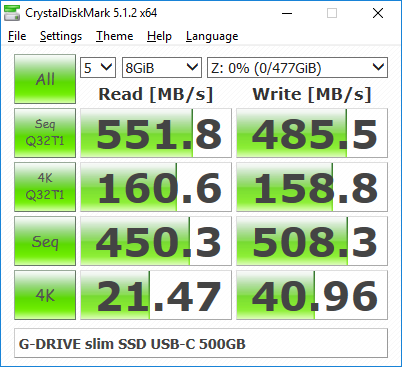
Our testing methodology for DAS units also takes into consideration the usual use-case for such devices. The most common usage scenario is transfer of large amounts of photos and videos to and from the unit. The minor usage scenario is importing files directly off the DAS into a multimedia editing program such as Adobe Photoshop.
In order to tackle the first use-case, we created three test folders with the following characteristics:
- Photos: 15.6 GB collection of 4320 photos (RAW as well as JPEGs) in 61 sub-folders
- Videos: 16.1 GB collection of 244 videos (MP4 as well as MOVs) in 6 sub-folders
- BR: 10.7 GB Blu-ray folder structure of the IDT Benchmark Blu-ray (the same that we use in our robocopy tests for NAS systems)






For the second use-case, we take advantage of PC Mark 8's storage bench. The storage workload involves games as well as multimedia editing applications. The command line version allows us to cherry-pick storage traces to run on a target drive. We chose the following traces.
- Adobe Photoshop (Light)
- Adobe Photoshop (Heavy)
- Adobe After Effects
- Adobe Illustrator
Usually, PC Mark 8 reports time to complete the trace, but the detailed log report has the read and write bandwidth figures which we present in our performance graphs. Note that the bandwidth number reported in the results don't involve idle time compression. Results might appear low, but that is part of the workload characteristic. Note that the same testbed is being used for all DAS units. Therefore, comparing the numbers for each trace should be possible across different DAS units.


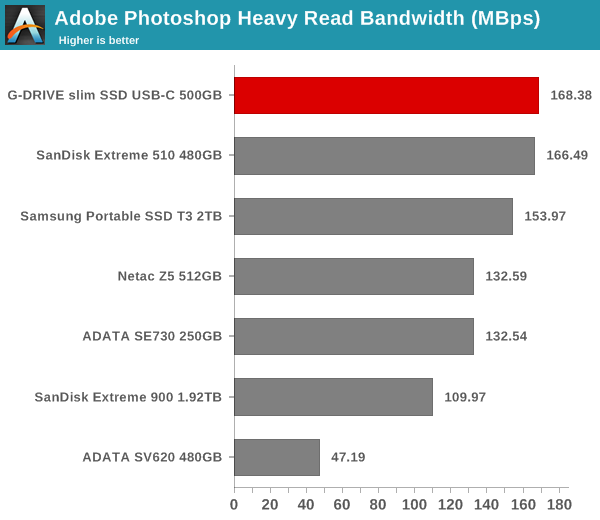

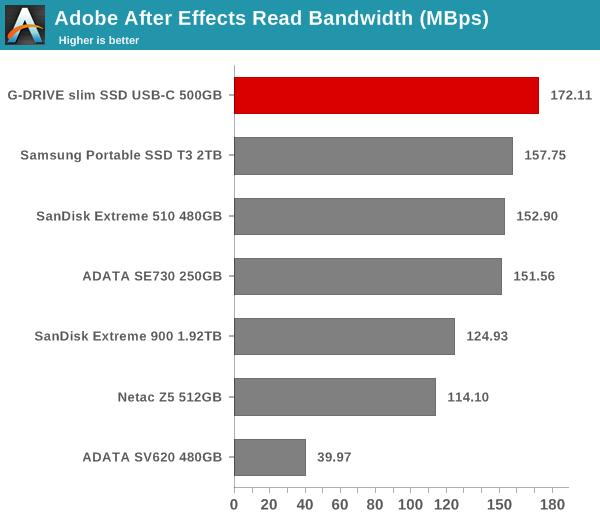

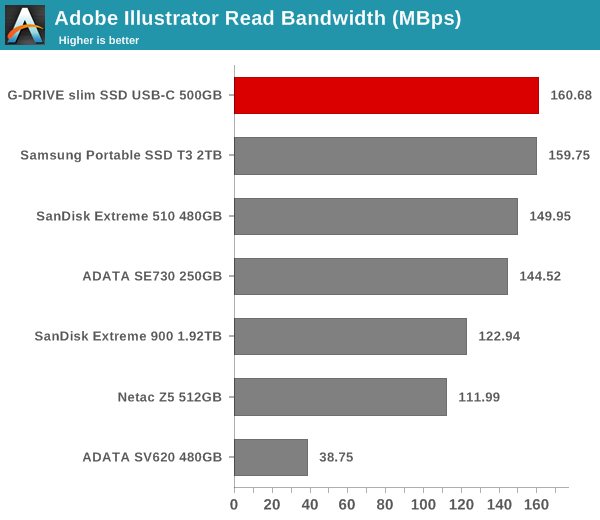

The above numbers show that SanDisk's TLC-based X400 can act as an effective external SSD, but, it still loses out to pure MLC-based SSDs and RAID-ed SSDs for workloads that put heavy stress on the SSD in terms of total traffic. That said, the USB 3.1 Gen 2 interface keeps it ahead of some of the USB 3.0 SSDs with MLC flash.
Performance Consistency
Yet another interesting aspect of these types of units is performance consistency. Aspects that may influence this include thermal throttling and firmware caps on access rates to avoid overheating or other similar scenarios. This aspect is an important one, as the last thing that users want to see when copying over, say, 100 GB of data to the flash drive, is the transfer rate going to USB 2.0 speeds. In order to identify whether the drive under test suffers from this problem, we instrumented our robocopy DAS benchmark suite to record the flash drive's read and write transfer rates while the robocopy process took place in the background. For supported drives, we also recorded the internal temperature of the drive during the process. The graphs below show the speeds observed during our real-world DAS suite processing. The first three sets of writes and reads correspond to the photos suite. A small gap (for the transfer of the videos suite from the primary drive to the RAM drive) is followed by three sets for the next data set. Another small RAM-drive transfer gap is followed by three sets for the Blu-ray folder.
An important point to note here is that each of the first three blue and green areas correspond to 15.6 GB of writes and reads respectively. Throttling, if any, is apparent within the processing of the photos suite itself. We see absolutely no issues with the thermal performance - The SSD temperature remains below 50C all through, and there is no thermal throttling at play here.
G-DRIVE slim SSD USB-C 500GBADATA SE730 250GBADATA SV620 480GBNetac Z5 512GBSamsung Portable SSD T3 2TBSanDisk Extreme 510 480GBSanDisk Extreme 900 1.92TBDespite the absence of thermal throttling, we see slight inconsistencies between transfers of the same set of data at different points in time. This is due to the SLC caching implementation and the overhead associated with transferring data from the SLC to TLC segments. That said, the effect is not bad enough for regular users to notice.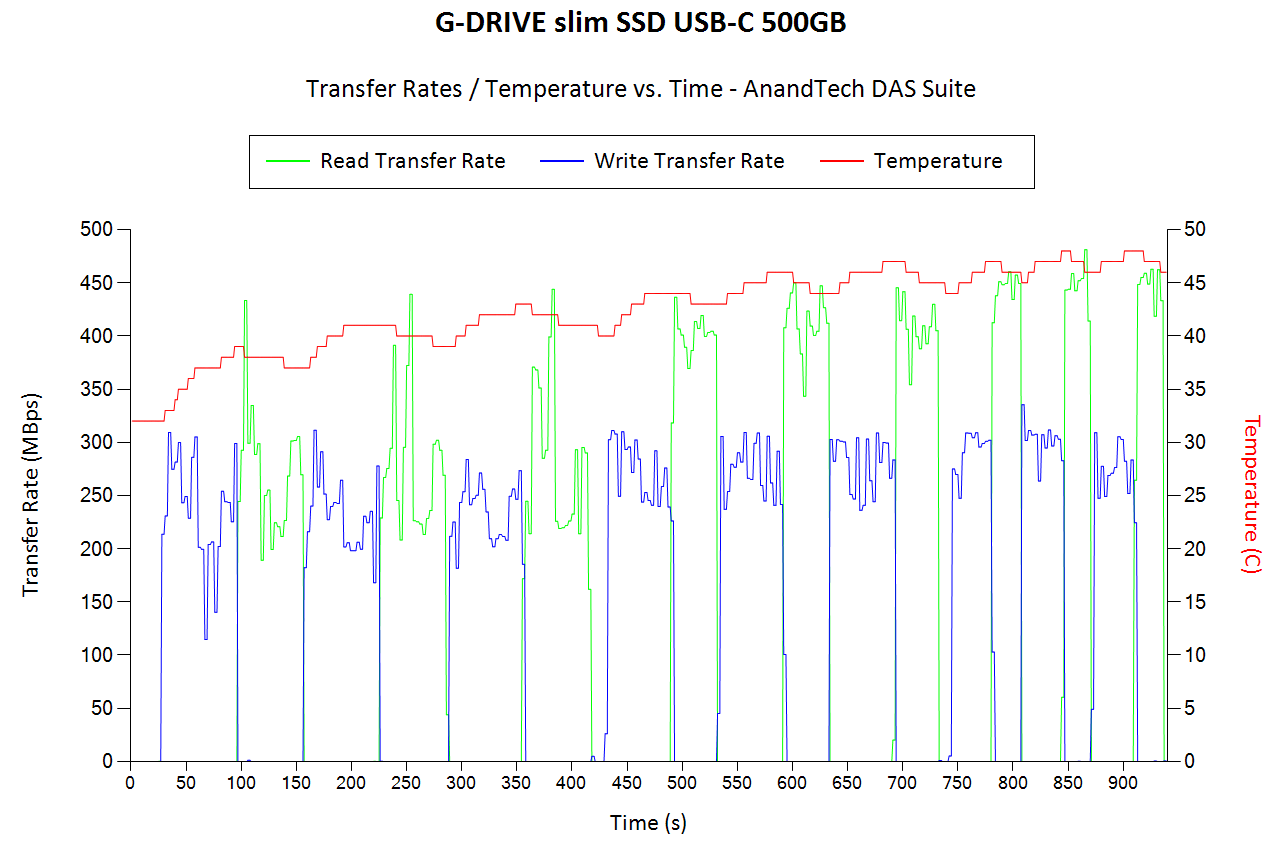
Concluding Remarks
G-Technology's G-DRIVE slim SSD USB-C is one of the first products in the external DAS space to take advantage of the synergies existing between various companies acquired by Western Digital over the past few years. The USB 3.1 Gen 2 Type-C interface shows that this is a product that looks forward to the future, and appropriately targets people with the latest and greatest computers. Despite that, the pricing is quite reasonable and actually matches several USB flash drives in terms of price per GB.
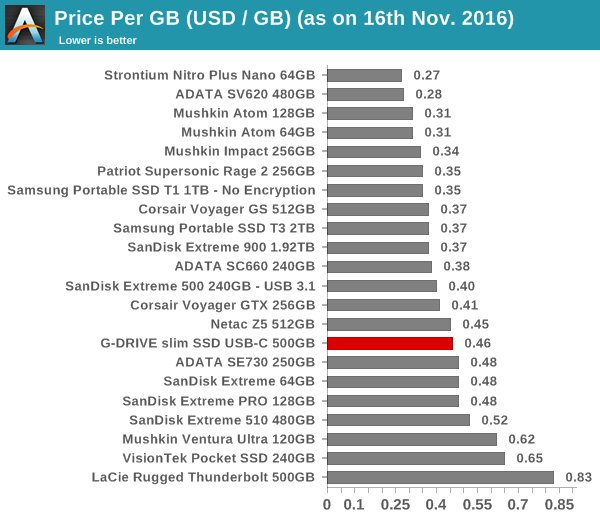
A minor point of concern is the policy of SanDisk to not implement translation of SCSI Unmap commands to TRIM in their external SSDs. We checked for TRIM support, and Windows reported an error indicating that the volume optimization operation was not supported by the hardware backing the volume.
Overall, we are impressed with the performance of the G-DRIVE slim SSD USB-C 500GB version and what it delivers for $230. That said, we would prefer adoption of MLC-based SSDs in this market segment, as TLC presents both long-term performance consistency and durability concerns which get amplified for heavy direct-attached storage workloads.
Buy G-Tech G-DRIVE slim SSD USB-C 500GB on Amazon.com
More...
-
11-16-16, 01:33 PM #6468
Anandtech: Promise Launches Pegasus3 External Storage via TB3: Up to 48 TB, 1.6 GBps
Promise has introduced three new storage systems using the Thunderbolt 3 interface and aiming users of the recently introduced Apple MacBook Pro notebooks. The new Pegasus3 Symply Editions can accommodate up to eight hard drives with up to 48 TB capacity and deliver up to 1.6 GB/s read performance (with HDDs), which will be beneficial for those working with large amounts of data, such as video professionals dealing with UHD content.
The Promise Pegasus3 Symply Edition external storage family consists of three models: the R4, the R6 and the R8 with four, six and eight 3.5” hot-swappable bays, respectively. The entry-level Pegasus R4 is offered with 12 TB of capacity and supports hardware RAID in 0, 1, 5, 6 and 10 modes. The more advanced Pegasus R6 and R8 feature capacities from 18 TB to 48 TB as well as support hardware RAID in 0, 1, 5, 6, 10, 50 and 60 (R8 only) modes. All of the Promise Pegasus3 Symply Edition storage solutions come with Symply’s Always-Up-to-Date management software for Apple’s macOS and Microsoft Windows. Remote monitoring applications for iOS and watchOS are also incoming.
All the Pegasus3 DAS systems come fully populated with Toshiba’s MD04ACA-series HDDs with a 7200 RPM spindle speed and 128 MB cache. The hard drives belong to consumer HDD lines and officially are designed for desktop computers. Nonetheless, Promise Pegasus3 storage devices are offered with three years of warranty support and 24/7 user support worldwide. Thus from reliability standpoint the new Pegasus3 systems should be in line with competing products from other makers.
As for performance, the Promise Pegasus3 are designed to support simultaneous streaming, editing, and backup of 4K video; the peak read/write speeds offered by the Pegasus3 R8 is around 1.6 GB/s when equipped with the aforementioned Toshiba hard drives in a RAID0 configuration. Meanwhile, when equipped with Samsung’s 840 EVO SSDs, the Pegasus R8 system is rated up to 2.7 GB/s throughput. Based on performance numbers supplied by Promise, the Pegasus3 offers 19-57% higher sequential read speed as well as 32-89% higher sequential write speed compared to its predecessor, the Pegasus2, depending on workloads.The Promise Pegasus3 DAS R4 R6 R8 HDDs Toshiba MD04ACA 3 TB Toshiba MD04ACA 3 TB
Toshiba MD04ACA 4 TBToshiba MD04ACA 4 TB
Toshiba MD04ACA 6 TBMaximum Number of HDDs 4 6 8 Capacity 12 TB (4 × 3 TB) 18 TB (6 × 3 TB)
24 TB (6 × 4 TB)32 TB (8 × 4 TB)
48 TB (8 × 6 TB)RAID 0/1/5/6/10 0/1/5/6/10/50 0/1/5/6/10/50/60 RAID0 Read Speed 797 MB/s 1140 MB/s 1660 MB/s Write Speed 800 MB/s 1070 MB/s 1660 MB/s RAID5 Read Speed 597 MB/s 933 MB/s 1460 MB/s Write Speed 580 MB/s 960 MB/s 1420 MB/s Ports 2 × Thunderbolt 3 PSU integrated Dimensions (W x H x L) 187 × 192 × 245 mm
7.3 × 7.5 × 9.6 inch187 × 251 × 245 mm
7.3 × 9.8 × 9.6 inch187 × 310 × 245 mm
7.3 × 12.2 × 9.6 inchCables Included USB-C (Thunderbolt 40Gb/s or USB 3.1 10Gb/s) cable Software Symply’s Always-Up-to-Date management software
for Apple’s macOS and Microsoft WindowsPrices 12 TB starts at $1499 18 TB starts at $2799 32 TB starts at $3999
Just like similar competitive DAS solutions, the Pegasus3 systems have two Thunderbolt 3 ports, making it possible to daisy-chain a display or another TB3 device to the storage arrays. The manufacturer bundles one Thunderbolt 3 cable certified for 40 Gb/s transfer rates with its new DAS.
The Promise Pegasus3 Symply Edition lineup will be available online from Apple and select retailers/resellers (including Apple and B&H). The Pegasus3 R4 with 12TB starts at $1499, the Pegasus3 R6 with 18TB starts at $2799 and the Pegasus3 R8 with 32TB starts at $3999.
Related Reading:
- LaCie Launches 6big and 12big: Up to 60/120 TB External Storage with Thunderbolt 3
- AKiTiO Introduces Node: Thunderbolt 3 eGFX Box for $299
- Apple Announces 4th Generation MacBook Pro Family: Thinner, Lighter, with Thunderbolt 3 & “Touch Bar”
More...
-
11-16-16, 03:37 PM #6469
Anandtech: HP Z2 Mini G3 Announced: Miniature Professional Workstation with Xeon and
This week HP has announced its new Z2 Mini G3 workstation, which weds a small form-factor with workstation-grade capabilities, along with rated reliability and performance. The new system can integrate Intel’s current and next-generation Core i7 or Xeon CPUs, NVIDIA’s Quadro GPU, two storage devices and up to 32 GB of DDR4 memory.
One of the desktop PC categories that is actually growing these days is SFF PCs. Such systems are faster than many outdated desktops and are designed to be subtle and discrete. While there are numerous makers of consumer computers that offer miniature PCs which are akin to Intel’s NUC, there are no workstations of the same size due to multiple reasons. For example, it is hard to offer workstation-grade endurance/reliability along with performance in a small enclosure due to thermals of desktop components, whereas usage of laptop parts is sometimes prohibitively expensive. Nonetheless, it still can be done. HP decided to capitalize on the SFF PC trend and used its expertise in developing commercial mini PCs as well as all-in-one workstations to develop a miniature workstation which would be small and powerful. The Z2 Mini G3 used to be called 'Ant-Man' internally, implying on a Marvell superhero character.
The HP Z2 Mini G3 measures 216×216×58 mm (8.5×8.5×2.28 inches), which is larger compared to Intel’s mainstream NUCs, but is smaller than SFF gaming systems like the MAGNUS EN980. The weight of the system starts at around two kilograms (4.5 lbs), it has 75/100mm VESA mounts and can be installed almost everywhere (behind the display, under the desk, on the desk, on the wall, etc.).
Gallery: HP Z2 Mini G3: Miniature Workstation with Xeon and Quadro





The workstation comes in black and to a degree matches the design of other HP Z machines, at least when it comes to versatile connectivity and functionality. For example, the higher-end Z2 Mini G3 models will offer four dual-mode DisplayPort connectors supporting up to six displays. In addition, the system will have four USB 3.0 Type-A and two USB 3.0 Type-C receptacles, a Gigabit Ethernet connector, a Wi-Fi 802.11ac + BT module, and a TRRS audio input.

Inside the Z2 Mini G3 there is a proprietary motherboard based on the Intel C236 PCH and featuring an LGA1151 socket supporting Intel Core i-series or Intel Xeon E3 processors (Skylake and Kaby Lake). The CPU is cooled-down by a relatively large blower. Given the fact that the total power draw of the system cannot be higher than ~180 W due to the power supply, we might not expect high-TDP microprocessors to be used inside the Z2 Mini G3, but it is reasonable to expect the system to support desktop-grade chips with 45-65W thermal design power (hence, four cores with HT, Iris Pro Graphics, etc.). The motherboard has two memory slots and can support up to 32 GB of DDR4 memory with or without ECC.
For graphics, the more advanced versions of the HP Z2 Mini G3 will come with NVIDIA’s Quadro M620 GPU (Maxwell, 384 stream processors, 30 W TDP) with 2 GB of GDDR5 memory that is certified to run professional CAD graphics applications. Alternatively, the entry-level HP Z2 Mini G3 models will use Intel’s integrated GPUs.
When it comes to storage, the HP Z2 Mini G3 supports one 2.5”/9.5 mm SATA HDD (or SSD) as well as one M.2-2280 HP Z Turbo Drive SSD (which is a re-badged Samsung SM951 SSD with NVMe and PCIe 3.0 x4 interface) with 256 GB or 512 GB capacity. The latter will be cooled-down using the airflow from the CPU blower to ensure consistent performance. Initially HP will support up to 1.5 TB of storage by its Z2 Mini G3 (1 TB HDD, 512 GB SSD), but eventually it may certify more capacious storage devices for the system.HP Z2 Mini G3 Specifications Entry High-End CPU Intel Core i3/i5/i7 Intel Xeon E3 v5/v6 PCH Intel C236 Graphics Intel integrated graphics NVIDIA Quadro M620
384 stream processors
2 GB GDDR5 memoryMemory Two SO-DIMM slots, up to 32 GB of DDR4, ECC supported Storage Up to HP Z Drive Turbo 512 GB PCIe 3.0 x4 with NVMe
Up to 1 TB SATA 6 Gbps HDDWi-Fi 802.11ac + BT 4.2 Ethernet Gigabit Ethernet with RJ45 connector Display Outputs 4 × DisplayPort++ Audio 3.5 mm audio in and audio out USB 4 × USB 3.0 Type-A (5 Gbps)
2 × USB 3.0 Type-C (5 Gbps)Specials Security latch to close USB ports from access Dimensions 216 × 216 × 58 mm
8.5 × 8.5 × 2.28 inchesPSU (external) 135 W (89% efficient, active PFC) 200 W (89% efficient, active PFC) OS Microsoft Windows 10 Pro or Linux Price $699 Unknown
All of HP’s Z2 Mini G3 systems will have a three year-long lifecycle option. The starting price of an entry-level SKU will be $699 and the systems will start to emerge in December. The more advanced models with Xeon and discrete graphics will naturally cost more and for the next-gen Intel Xeon E3 featuring the Kaby Lake microarchitecture customers will have to wait until early next year.
Gallery: HP Z2 Mini Briefng Deck





Related Reading:
- HP Unveils Third-Gen All-In-One Z1 Workstation: 4K Display, Intel Xeon, Professional Graphics
- HP Announces The Pavilion Wave And Elite Slice Desktops
- HP Updates The Z240 Workstation With The Core i7-6700K
More...
-
11-17-16, 06:51 AM #6470
Anandtech: Qualcomm Announces Quick Charge 4: Supports USB Type-C Power Delivery
Qualcomm did more than reveal the name of its next SoC, the Snapdragon 835, today at its Snapdragon Technology Summit in New York. It also announced an update to its fast-charging technology. Qualcomm’s Quick Charge 4 promises up to 20% faster charging and 30% higher efficiency than the previous generation Quick Charge 3 found in many current flagship phones.
This latest generation brings a number of improvements, but perhaps the most remarkable change is that Quick Charge 4 is now compatible with the USB Type-C and USB Power Delivery (USB-PD) specifications set by the USB-IF standards body. Previous implementations of Qualcomm’s proprietary charging technology alter the voltage delivered over Vbus to increase the charging rate, which violates the Type-C specification for standard charging that only allows for changing the charging current. They also use a different method for negotiating the charging parameters using the USB data lines that runs afoul of the Type-C specifications too. Quick Charge 4 addresses these issues and should satisfy the language Google recently added to its Android 7 Compatibility Definition Document (CDD) recommending device OEMs not use proprietary charging methods that are not compatible with USB-PD.
Quick Charge 4 also uses an updated version of Qualcomm’s INOV (Intelligent Negotiation for Optimum Voltage) power-management algorithm that now includes real-time thermal management to help optimize power transfer. It also uses an updated version of its Battery Saver Technologies that uses stepwise charging to help the battery maintain at least 80% of its original charge capacity after 500 charge cycles.
Battery health and charging safety are fresh on everyone’s minds after the battery fires that plagued Samsung’s Galaxy Note7. It’s only natural then that Qualcomm made safety a point of emphasis during its presentation. Quick Charge 4 incorporates over-voltage, over-current, and four levels of over-temperature protection, including chassis, battery, and PMIC temperature sensing. It can also sense the type and quality of the charging cable and adds additional protection from over-charging. Qualcomm says that protection “is implemented at multiple levels and throughout the entire charging process to more accurately measure voltage, current, and temperature while protecting the battery, system, cables and connectors.”
Qualcomm’s Quick Charge 4 will be available on devices using the Snapdragon 835 SoC and its two new power managements ICs (PMICs), the SMB1380 and SMB1381. The two PMICs work in tandem as part of the Dual Charge++ feature for improving efficiency, reaching 95% peak efficiency at 3A. The PMICs will be available by the end of 2016 and will be integrated into devices shipping in the first half of 2017.
More...
Thread Information
Users Browsing this Thread
There are currently 16 users browsing this thread. (0 members and 16 guests)




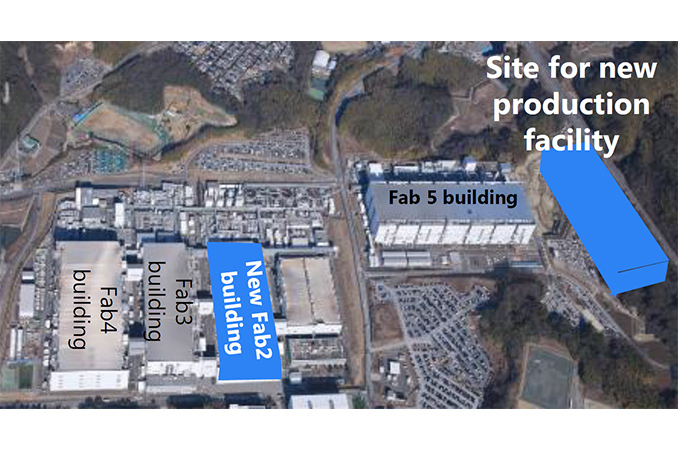
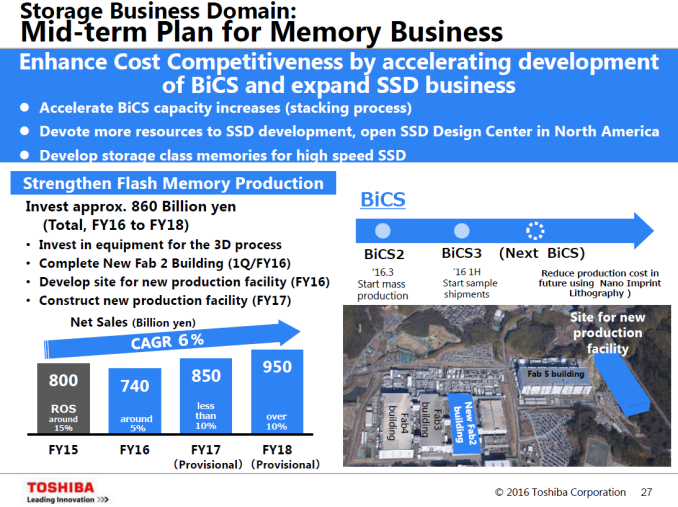
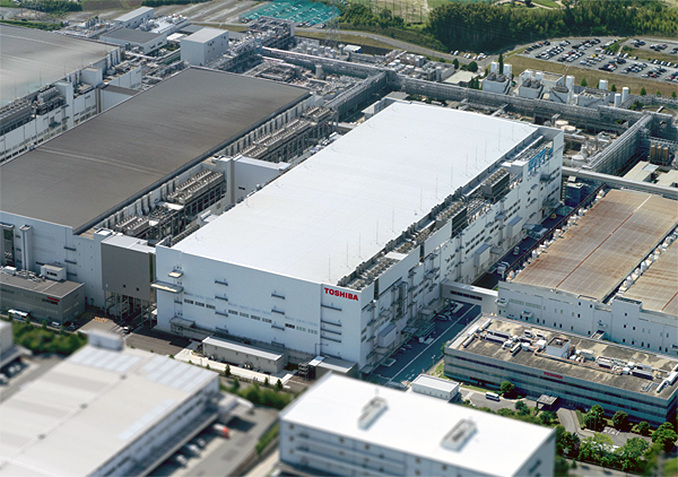

 Quote
Quote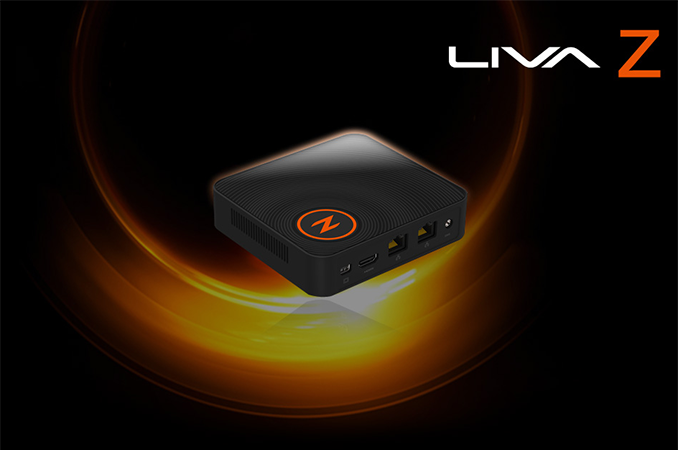
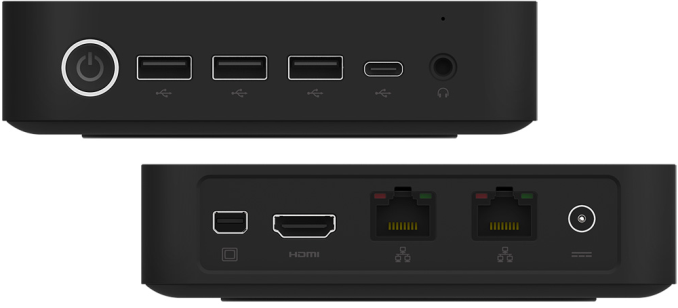
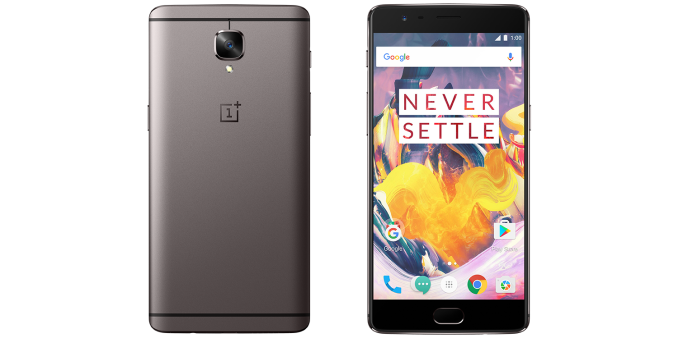

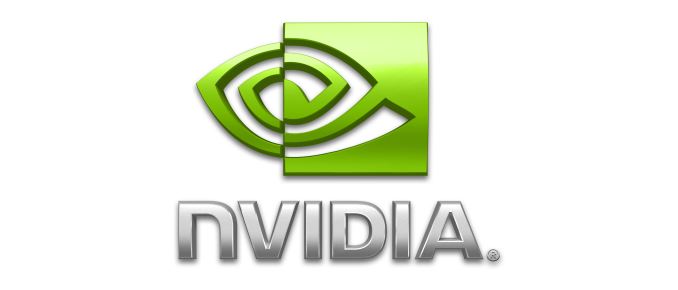

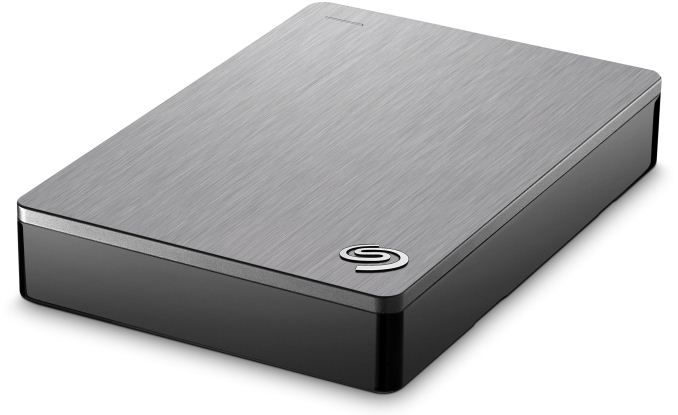
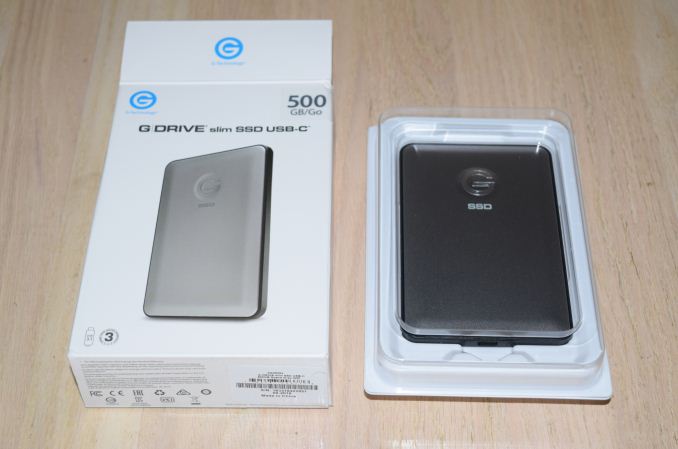

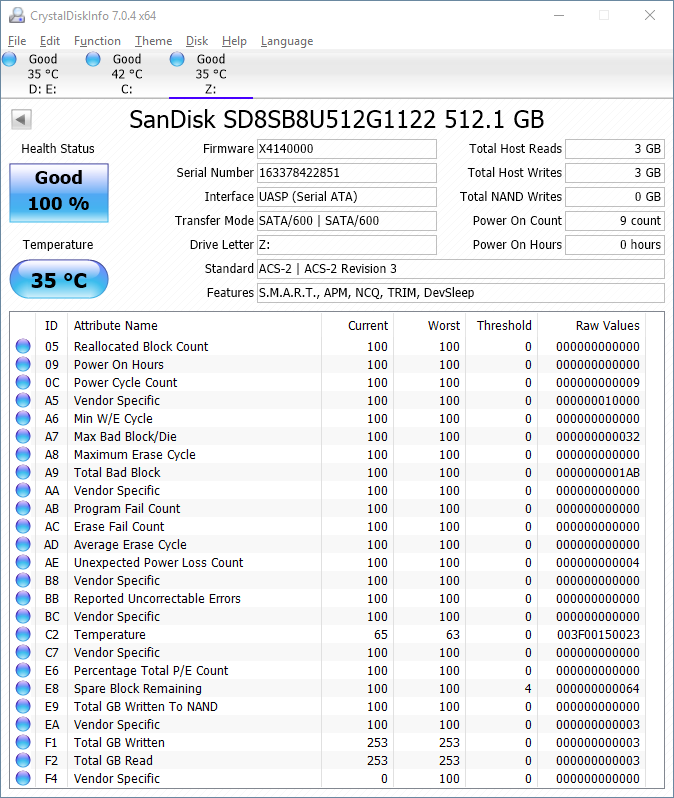








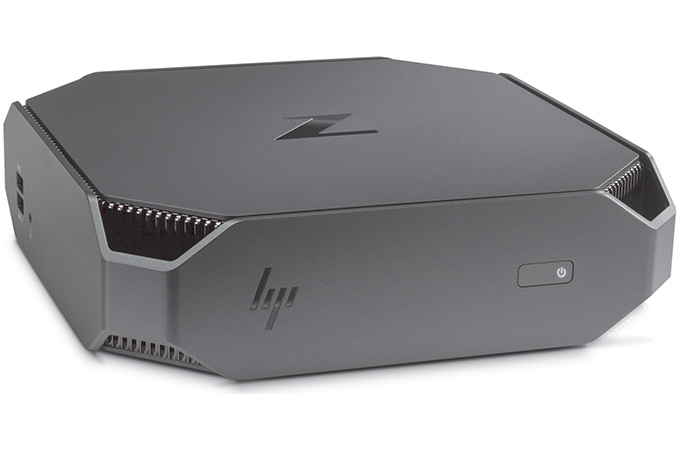




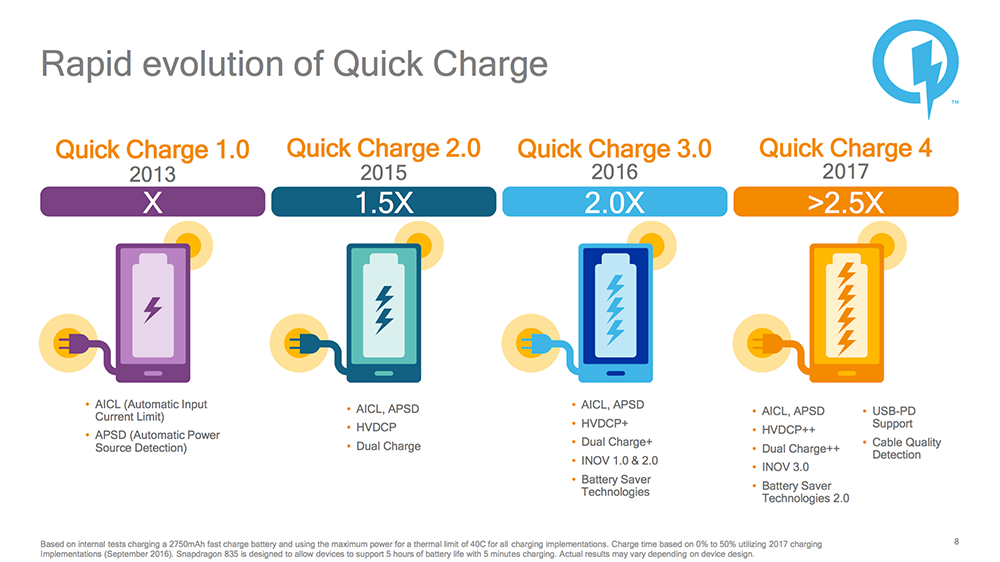
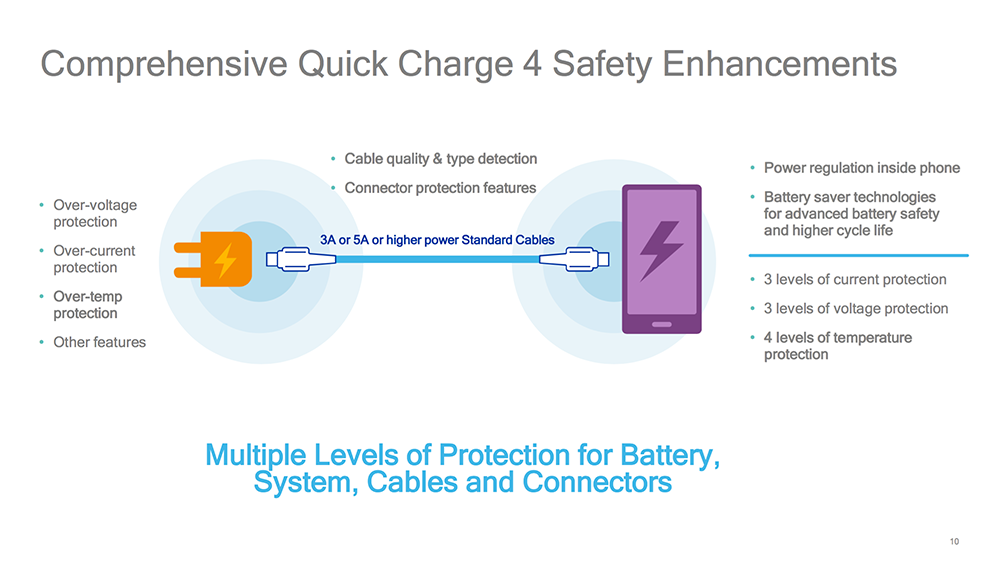
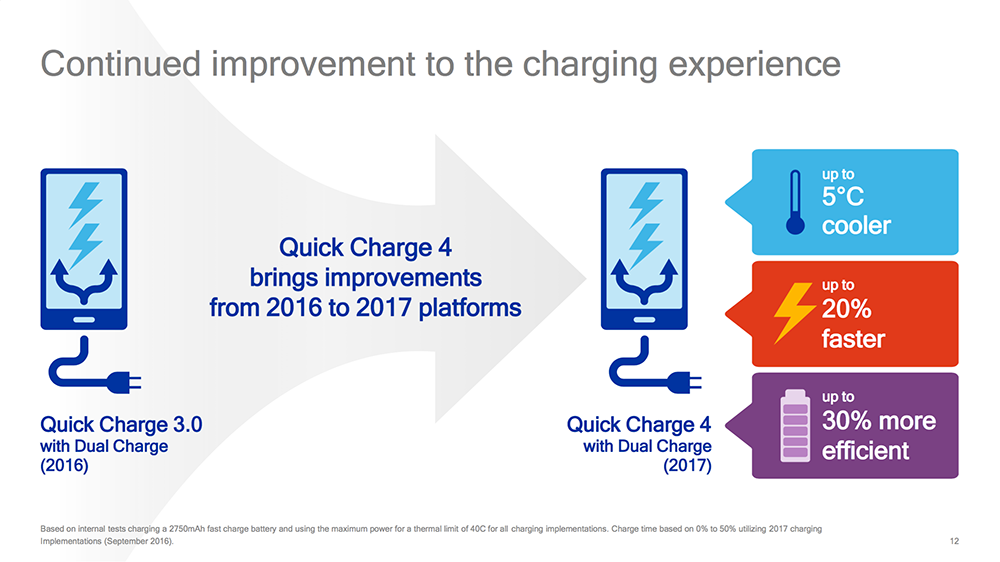
















Bookmarks